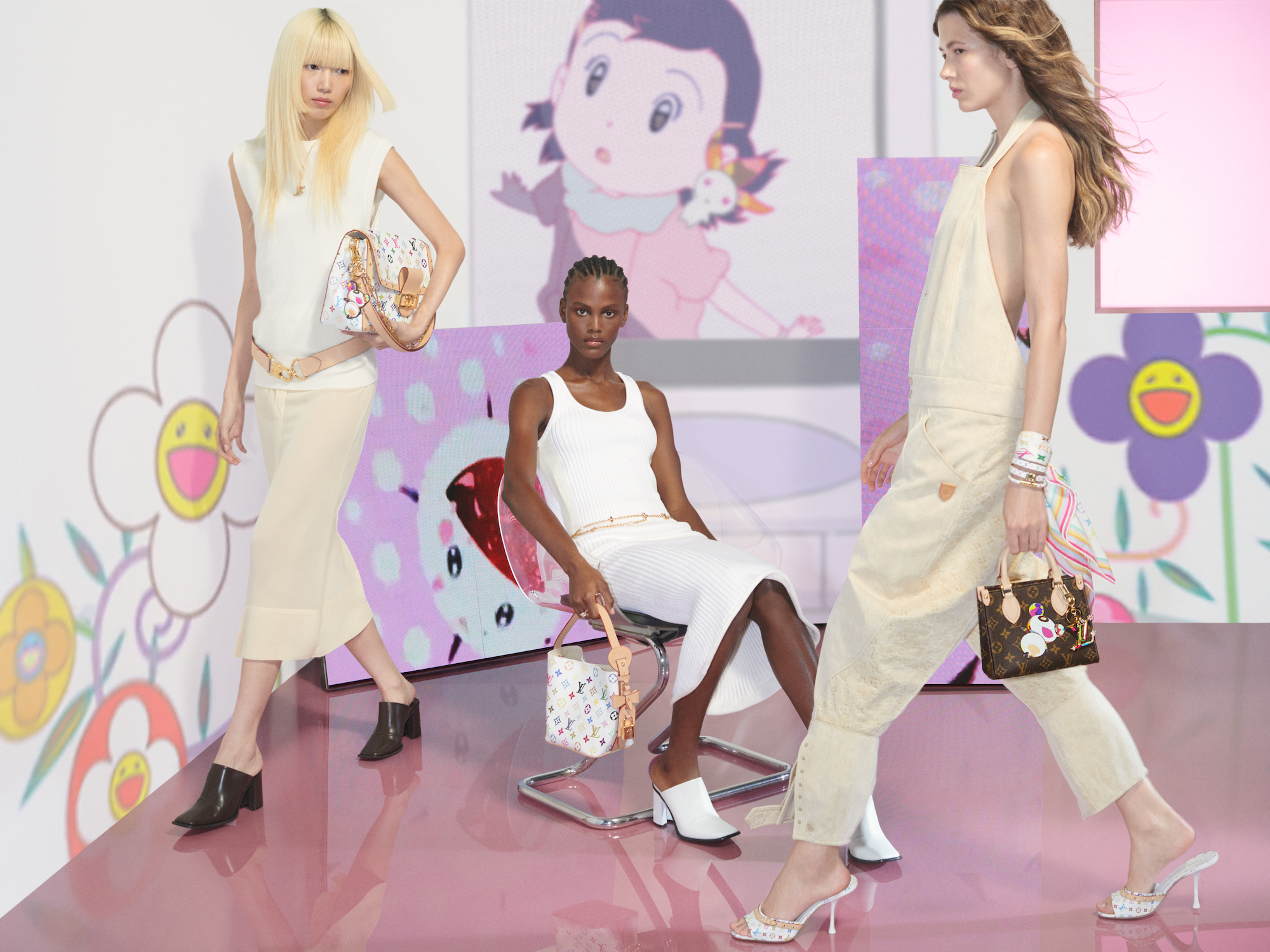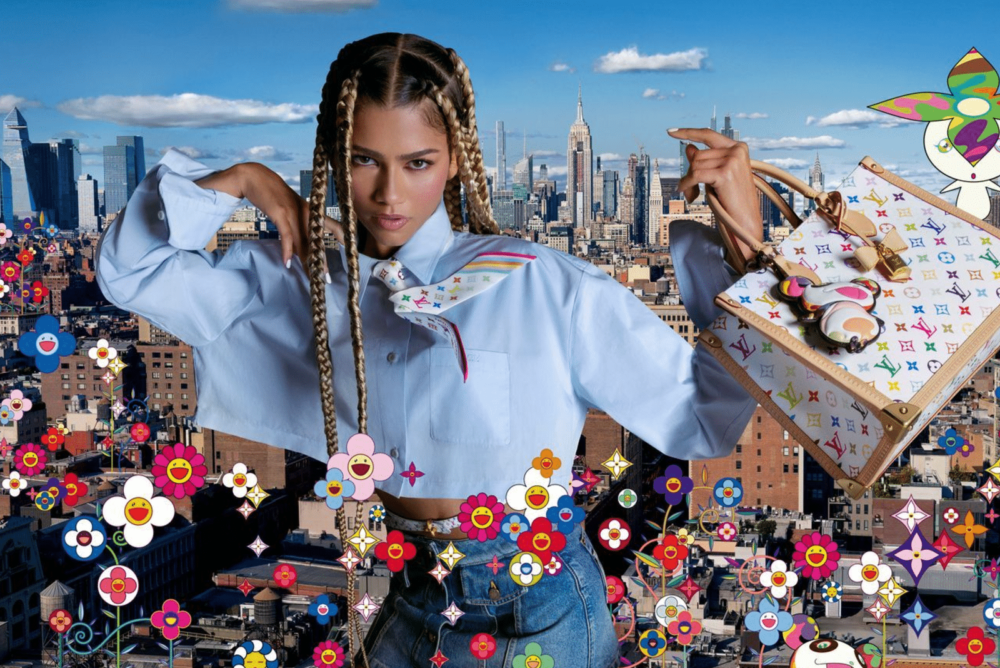The cherry on top of the Louis Vuitton x Takashi Murakami ad campaign that debuted earlier this month is undoubtedly the odd soundtrack choice of “Immaterial,” the hyper-pop anthem by the late great Sophie. Arriving twenty years after Vuitton and Murakami first collaborated in 2003, the capsule collection is not necessarily monumental or particularly beautiful (the collaboration has oft been critiqued for its inherent gaudiness), but rather, its strange nature offers something even more valuable than beauty: it is genuinely interesting.
Some of my interest in the collection is its star, the ever-regal House Ambassador Zendaya, who frolics among Vuitton-ified iterations of Murakami’s kawaii grotesque superflat creatures and poses in a dreamscape fusion of LV’s emblematic codes with Murakami’s whimsy avant-garde, backlit by Sophie’s “Immaterial.” A few ironies stand out here. “Immaterial” is a song in which Sophie expressly resists and complicates the naturalness of pop structures and hegemonic principles of gender to transcend their material forms. Like Sophie, Murakami too is an artist of postmodern pop spirits, spectral entities, and dream-fiends — the immaterial! —, and yet here his creatures are, being carved and stamped onto a copy of a copy of a designer bag, being sold to millions as literal materials.
Altogether, the entire artifice of the collaboration expresses an aesthetic that borders on hollow and uncanny rather than the intended “vivacious” and “kaleidoscopic” as advertised. With these choices, the campaign’s glossy veneer belies its overarching contradiction: the song is called “Immaterial,” and alongside a splash of Murakami’s cute super-flattened zombified spirits — pun intended — it is being used to promote mass-produced luxury goods, the apexes of materialism. The dissonance is striking, but in other ways, this is perhaps exactly what Sophie would have wanted. And perhaps with Murakami in the mix, it creates a perfect storm of the prime absurdity of big fashion business; where art, culture, fashion, and technology collide in a bizarre spectacle of commodified beauty.
Sophie, a fiercely independent artist and pioneer of the hyper-pop genre, passed away in 2021. Her music roiled with subversive intent around commerciality, seeking rebellion against material definitions of identity and the hegemonic systems of capital by operating within those very systems through a fringe philosophy some have identified as accelerationism. As an intellectual movement, accelerationism believes in intensely speeding up automation, computer technology, and aggressive global capitalist enterprise to achieve salvation through the emergence of a post-capitalist structure of technological and human progress. In her sound engineering, for example, Sophie accelerated the mechanisms of pop and capital to such extremes that they either crashed and burned or became self-parodies, ultimately transforming into something beautifully new, free, and fiercely alien: hyper-pop.
Sophie’s work, as Simone A. Medina Polo noted in a 2021 essay, functioned to dismantle the constraints of identity. In Sophie, one became a “body without organs,” a self utterly deterritorialized; unmoored and therefore freed from cultural and ideological origins through a complete symbiosis of biological, socio-systemic, and virtual ecosystems. With Sophie, machines fueled by oil turned into pearls flowing with the oil of their un-insides. Blood became an essence rather than mere singular human product. Materiality was deconstructed and then transcended.

In “Immaterial” especially, Sophie dissolves boundaries and binaries by merging them. On the penultimate track on her debut album “Oil of Every Pearl’s Un-Insides,” Cecile Believe’s voice echoes: “With no name and with no type of story…We’re just immaterial.” The opening track on the album, called “It’s Okay to Cry” features Sophie’s own vocals—the first time she sang on her own track. The music video, released in 2017, exposed her bare-breasted in closeup, with shiny red lipstick and a mould of fiery-orange hair, in front of a shifting dream-like sky. It was pop hatched from the egg of a glittering bionic insect. Under the combined artifice of synth, electronica, and the avant-garde, the song bespoke wonder at the possibilities of the transhuman in the expression of the trans human. As Jia Tolentino writes in her review of Sophie’s posthumous album “Sophie,” “She had translated her life and her questions into these new sounds…in which states of flux could be captured in digital permanence, in which alteration was how you approached the divine.”
In keeping with the idea of merging with capital in order to dismantle it, it is significant that the “It’s Okay to Cry” music video also served as the “monumental” backdrop of Louis Vuitton’s spring/summer 2020 show as poignantly described by Steph Eckardt and Serichai Traipoom for W magazine: “blaring a message of self-acceptance…models did their best to draw the audience’s attention back to Nicolas Ghesquière’s latest collection… ”
Sophie acquiesced to her name and image being used to sell monogrammed bags and high-end accessories in 2017. On some level, the spectacle had worked enough to embarrass even the glamour of the clothes on the runway. So why wouldn’t she be fine with it in 2025? Further to this, why would not the effect be the same if not stronger with the addition of Murakami in the mix? Remember that Sophie’s 2015 single “Lemonade” appeared in a McDonalds commercial for lemonade. Remember too that in 2020, Sophie’s squelching bass banger “Ponyboy” similarly featured in an Adidas x Ivy Park ad campaign.
I have long associated the flower-patterned emblems of Louis Vuitton with fashion as an ideal product rather than style as a personal practice. Fashion, as Anouchka Grose describes in her recent book “Fashion: A Manifesto,” is being told what to wear. Style is knowing how to wear it for yourself. In a social economy governed by beauty standards and the worship of status, in which the self is pressed down by the pressure to conform and stand out simultaneously, expensive clothes push us towards desirability by altogether signalling wealth, taste, intelligence, and sensitivity to the cultural zeitgeist. In this world, an LV x Takashi Murakami monogram speedy is an asset because it allows us to safely conform to what is trendy while (loudly) expressing some aspect of our own cool. If we take the word “branding” literally, we can acknowledge that as much as the logo binds us to the material value of the bag, it also claims us to prestige in a way that fills us with a nice, warm pride.

It makes sense that these enterprises are drawn to Sophie’s sound. With Louis Vuitton; with its interwoven LV initials, the four-pointed star, the four-petaled flower, and the sharp concave diamond; identity comes from the production, selling, and re-presentation of the insignia. The brand pairs nicely with Takashi Murakami, who recently humorously acknowledged on the Louis Vuitton [Extended] podcast that “stealing” Japanese culture to “sell it in an easy way to the Western World” is a part of his creative practice. While these figures may approach Sophie in the tradition of cannibalizing transgressive subcultures, repackaging them, and selling them back as commodities, she remains three steps ahead: it is her they are serving in that ad campaign.
While the LV x Murakami collaboration may not have aimed for strangeness or the uncanny, this is precisely what I take away from it. Sophie still remains in opposition to the modes of capital and hegemony, but she signals this from inside the machine itself. Like a worm wriggling into an apple and eating at its core, she winks at us from inside that monogram Louis Vuitton x Murakami speedy to say: “Isn’t this all a bit ridiculous?”

Jonathan Divine Angubua is currently finishing his undergraduate studies at the University of Toronto. He enjoys any interesting art and is always looking for great book recommendations. As a writer and lover of fashion, he is most inspired by strangeness and beauty.

